Mar 16
Posted: under Activities, Plantlife, Water, Weather.
Tags: beauty, observation, photography, water resource management, Weather March 16th, 2009
Plants around here take immediate advantage of water, so the change in color after less than a week from the first drop of rain is striking. Not only does green show on the mowed maintenance path, but at the base of the taller clumps to either side. Rain started Wednesday; this was taken Sunday. Last […] [...more]
Plants around here take immediate advantage of water, so the change in color after less than a week from the first drop of rain is striking.

Near Meadow
Not only does green show on the mowed maintenance path, but at the base of the taller clumps to either side. Rain started Wednesday; this was taken Sunday. Last week, no green.
Read the rest of this entry »

Mar 09
Posted: under photography, Plantlife, Wildlife.
Tags: beauty, native plants, photography, wildlife management March 9th, 2009
We saw a Luna Moth again today. It might have been the same one or another one. This was in the mid-morning of a cloudy day, with a strong wind from the S (the other side of the fence. The white “frosting” on the forewing purple stripe is (when really enlarged) white scales mixed with […] [...more]
We saw a Luna Moth again today. It might have been the same one or another one. This was in the mid-morning of a cloudy day, with a strong wind from the S (the other side of the fence.
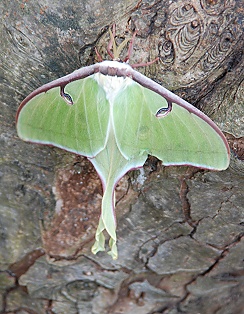
Luna Moth
The white “frosting” on the forewing purple stripe is (when really enlarged) white scales mixed with the purplish ones. You can just see the underwing eyespots showing through.
Read the rest of this entry »

Mar 07
Posted: under photography, Wildlife.
Tags: beauty, photography March 7th, 2009
Until today, I had never seen a Luna Moth. On the evening of my birthday, Richard found one clinging to a twig low under a rusty blackhaw viburnum. I rushed out with the camera. We think this moth had just emerged and begun the “stretching out” process, but we know very little about them. Richard […] [...more]
Until today, I had never seen a Luna Moth. On the evening of my birthday, Richard found one clinging to a twig low under a rusty blackhaw viburnum. I rushed out with the camera.
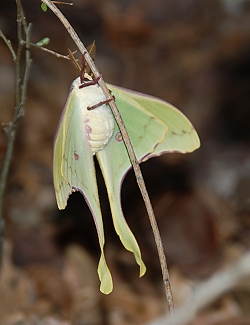
Luna Moth
We think this moth had just emerged and begun the “stretching out” process, but we know very little about them. Richard said they were fairly common in rural Alabama when he was a child, with “moth-watching parties” in the evenings.
Read the rest of this entry »

Mar 04
Posted: under Land, Plantlife, Weather, Wildlife.
Tags: beauty, native plants, photography, Weather, wildlife management March 4th, 2009
Even in a year this dry, some of the native plants (and a few non-natives) do their best to keep alive and growing. One of the natives we’ve nurtured for years in the yard is the scarlet buckeye, an understory tree that hates sun and drought–but thrives in shady canyons near permanent water. Our version […] [...more]
Even in a year this dry, some of the native plants (and a few non-natives) do their best to keep alive and growing.
One of the natives we’ve nurtured for years in the yard is the scarlet buckeye, an understory tree that hates sun and drought–but thrives in shady canyons near permanent water. Our version of that is the shade of a big old ash and regular watering. I’d like to move its progeny into the creek woods, but right now they’re far too dry (and too far away to water.) It’s just showing its flower buds now; they’ll be open in a few days.
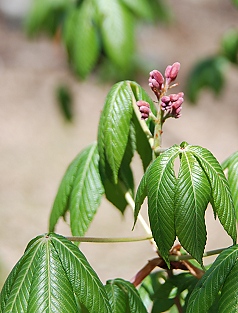
Read the rest of this entry »

Feb 26
Posted: under photography, Plantlife, Wildlife.
Tags: Animal behavior, beauty, native plants, photography February 26th, 2009
Mexican plum, the tree-sized wild plum around here, blooms even in drought years. Not only is it snowy white and beautiful, it has that amazing wild-plum fragrance…and as it’s an early bloomer, it attracts everything that’s hungry for nectar. It doesn’t look like this long–especially in a drought year–and the tiny white petals are already […] [...more]
Mexican plum, the tree-sized wild plum around here, blooms even in drought years. Not only is it snowy white and beautiful, it has that amazing wild-plum fragrance…and as it’s an early bloomer, it attracts everything that’s hungry for nectar.
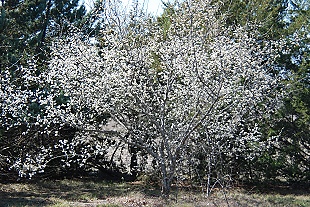
Mexican Plum in full bloom
It doesn’t look like this long–especially in a drought year–and the tiny white petals are already blowing off it in today’s stiff warm breeze.
Read the rest of this entry »

Feb 22
Posted: under photography, Wildlife.
Tags: observation, photography February 22nd, 2009
Even in a drought year, trees put out buds–at this time of year, the elms and hackberries and the early oaks may flower, and some of the migrant birds enjoy a lofty “salad” of buds from them. Here’s one of our taller elms showing golden-green lace against the blue sky. [...more]
Even in a drought year, trees put out buds–at this time of year, the elms and hackberries and the early oaks may flower, and some of the migrant birds enjoy a lofty “salad” of buds from them. Here’s one of our taller elms showing golden-green lace against the blue sky.
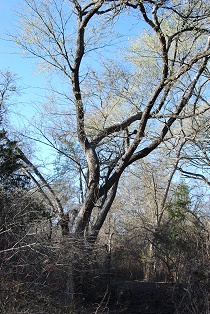
Early spring elm
Read the rest of this entry »

Feb 13
Posted: under Wildlife.
Tags: photography, snake February 13th, 2009
Though we have some large snakes on the place, most of the snake species are small, and we’re lucky if we get a glimpse of them. This little gray snake with the black head and orange “collar” is barely a foot long and skinny as a pencil–easy to miss, if it weren’t that we’re in […] [...more]
Though we have some large snakes on the place, most of the snake species are small, and we’re lucky if we get a glimpse of them. This little gray snake with the black head and orange “collar” is barely a foot long and skinny as a pencil–easy to miss, if it weren’t that we’re in severe drought and the grass to hide it just isn’t there.
This is a Prairie Ring-necked Snake, Diadophis punctatus arnyi, a shy little creature that sometimes freezes long enough to have its picture taken.
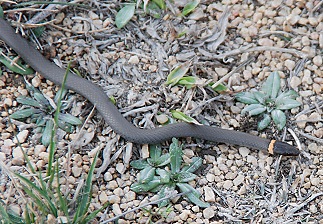
Prairie Ring-necked Snake
Read the rest of this entry »

Feb 13
Posted: under Activities, photography, Plantlife.
Tags: Activities, drought, photography February 13th, 2009
Even in a dry year, spring comes early to central Texas. I’m recovering from pneumonia so can’t get out to the full 80 acres, but here are some pictures from around the house. (I need to plant some elbowbush up by the house, as it’s one of the very earliest.) Rusty blackhaw viburnum is one […] [...more]
Even in a dry year, spring comes early to central Texas. I’m recovering from pneumonia so can’t get out to the full 80 acres, but here are some pictures from around the house. (I need to plant some elbowbush up by the house, as it’s one of the very earliest.)
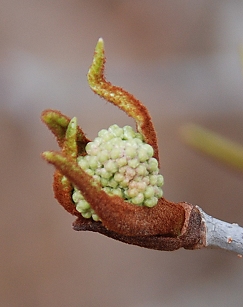
Rusty Blackhaw Viburnum bud
Rusty blackhaw viburnum is one of the most beautiful of the native shrubs, but it’s routinely scraped off by developers as “brush”. Here, the buds are just opening to show the bud-cluster that will be a puffball of pure white within a week. Easy to see why it acquired the name “rusty.” It’s a valuable plant for wildlife, producing tasty blue berries for birds–and nectar for the early butterflies and moths.
Read the rest of this entry »

Feb 05
Posted: under photography, Wildlife.
Tags: Activities, bird behavior, photography February 5th, 2009
In December 2002, I was birdwatching at the site of what would be Fox Pavilion (hadn’t been built yet.) We had a flock of cardinals that showed up every day…but that day, there was a female bird with them that wasn’t a cardinal. It was a Pyrrhuloxia, a close relative whose normal range is well […] [...more]
In December 2002, I was birdwatching at the site of what would be Fox Pavilion (hadn’t been built yet.) We had a flock of cardinals that showed up every day…but that day, there was a female bird with them that wasn’t a cardinal. It was a Pyrrhuloxia, a close relative whose normal range is well west of here.
I had only a little point and shoot camera then, and it was a heavily cloudy day, late in the afternoon, so my pictures of the female Pyrrhuloxia weren’t very good–just good enough to show that’s what it had to be. That female was somewhat melanistic, very dark indeed, noticeably darker than the female cardinals perched in the same scrubby trees.
I watched every winter, but did not see another one until today: on the feeder in the back yard. I wasn’t able to get a picture of it except through the study window–old glass, and can’t be opened so it can’t be cleaned–so it’s blurry–and handheld with my less-great lens, but here it is:
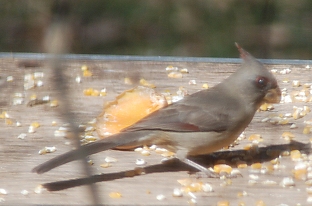
Pyrrhuloxia, female
Note that the bill is yellow, with the upper part (culmen) sharply curved, and the bird is a cool gray, with minimal red in the crest, around the eye, and in the folded wing.
Here’s a female cardinal (but this taken outside, so there’s no blurring by the old dirty glass in the window and with my best lens) as gray as they look in our yard–usually they show warmer colors–and always the red bill and more red in crest, eyes, wings, and tail.
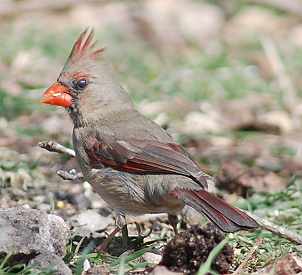
Even though the Pyrrholoxia picture isn’t as good as I’d wish, it’s still nifty to see one back again, this time in sunlight and close enough to see details with the binoculars. I expect these “desert cardinals” (as we called them when I was a kid) to appear in our area more often as climate change makes it hotter and dryer.

Jan 18
Posted: under Activities, photography, Plantlife, Wildlife.
Tags: Activities, photography, wildlife management January 18th, 2009
Yesterday was the “nose to the grindstone” day for putting the annual report in final form, including choosing which pictures to include to show the story of the year on our place. The official form has nine pages. Add to that a cover sheet with our names and other useful information the form itself doesn’t […] [...more]
Yesterday was the “nose to the grindstone” day for putting the annual report in final form, including choosing which pictures to include to show the story of the year on our place.
The official form has nine pages. Add to that a cover sheet with our names and other useful information the form itself doesn’t have space for, and three pages of supplementary notes referencing specific points of the form (which, for instance, does not have a check-box for “check-dams/gabions” under “erosion control”–just ponds, dykes, and levees, so I have to add a note about our check-dams and gabions every year) , and then 14 pages that I call the Activity Report, detailing (well, outlining, but in more detail than their Annual Report Form makes possible) the activities we’ve done in each of the seven management areas with (where possible) photographs.
(Photos beyond the break)
Read the rest of this entry »











